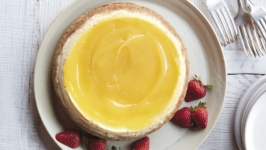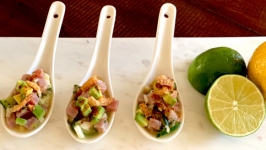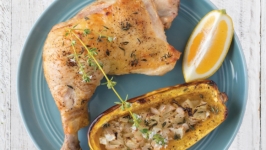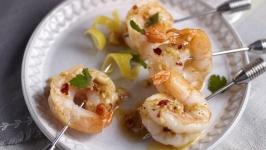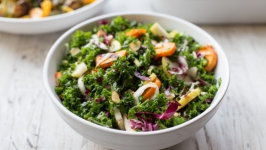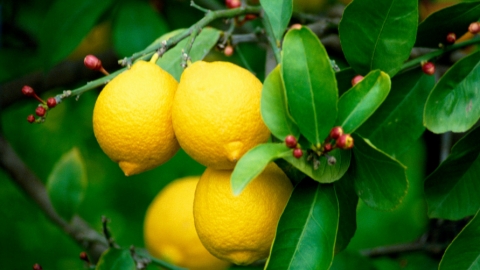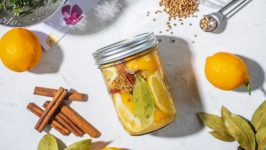My-Oh-Meyer Lemons
Winter Sunshine on Tap with a Juicy Squeeze of the Bay Area’s Favorite Citrus
Peak citrus season is upon us, brightening the winter doldrums. While there are enormous varieties of citrus showing up at markets, the darling of Silicon Valley is the Meyer lemon. With its slightly sweet flavor and ethereal perfume, the arrival of this smooth-skinned hybrid in farmers markets and stores is highly anticipated by chefs and home cooks alike. Perfect for when you want a burst of lemon without that acidic bite. The Meyer has had a cult following since the turn of the 20th century, but its rise to prominence has not been without a few twists and turns.
Most people know what a lemon is, but can everyone tell the difference between lemons? Probably not. More importantly, are all lemons interchangeable? Not all of the time.
Some 90% of lemons available in markets are the Eureka and Lisbon, primarily grown for their acidic juice. Often referred to as “true” lemons, they are indistinguishable in their tart flavor, aroma and acidity. Differentiation lies in their physical characteristics: The Eureka has knobby, thicker skin and a shorter neck; the Lisbon is smoother, oblong and the blossom end tapers to a slight point. The Eureka contains seeds and has less juice than the seedless Lisbon. Both lemons are ideal in dishes where you are looking for jolt of tartness.
In contrast to the true lemons, the Meyer, a hybrid of a lemon and mandarin orange, is smaller, rounder and smoother with a golden skin the color of fresh egg yolks. The skin is much thinner and has less of the white pith common with the Eureka and Lisbon lemons, which means it is possible to eat the lemon in its entirety, peel included. And 40% of the weight of a Meyer is juice, making it much juicier than the Eureka and Lisbon.
Taste is the most notable difference. The Meyer has a natural sweetness and lower acidity that heightens the flavor of foods without adding bitterness. Floral notes of pine and thyme contribute to the pleasing aroma and give the Meyer a gentle complexity. The zest of Meyer lemons is bright and fragrant, with a hint of subtle spiciness. And as with other lemons, they can be added raw to dishes like salads, salsas or desserts. That delicacy, though, needs to be handled with care. The aroma and flavor of the Meyer are diminished when paired with bold ingredients or too much heat. If you want the Meyer flavor but need tartness, add it from another source such as wine vinegar.
Tracing the Roots of Meyer Lemons
The Meyer lemon was brought to the US from southern China in the early 1900s by a US Department of Agriculture agricultural explorer named Frank N. Meyer, for whom the fruit is named.
In the 20th century, the citrus industry went through a major transformation fueled by faster transportation such as railroads and airplanes, commercial refrigeration, the discovery of vitamin C and, most importantly, the invention of juice concentrates. The Meyer lemon was left behind in this transformation, never making its debut on a national scale. Distribution was confined mostly to markets near the citrus belts of California and Florida.
Their thin, delicate skin and high juice content makes them too fragile to distribute commercially. To complicate matters, in 1960 the majority of Meyer lemon trees in California were destroyed by the citrus virus tristeza, which threatened the entire citrus industry. Government officials ordered the eradication of Meyer lemon trees from orchards, ranches and even backyards. Fortunately, scientists at UC Riverside invented a virus-free Meyer, the “Improved Meyer,” and chefs and home cooks breathed a sigh of relief.
Becoming a Celebrity Citrus
Most people in the Bay Area trace the Meyer’s popularity directly to Alice Waters and Chez Panisse.
In the 1970s, Alice and her team found them while foraging in the backyards of Berkeley. The ethereal fragrance and sweetness of this lemon quickly made it a signature ingredient in sweet and savory menu items at her fabled restaurant.
Championing this delicate citrus in her cuisine, most notably with her legendary Meyer Lemon Meringue Pie, Alice put Meyer lemons on everyone’s shopping wish list. And it didn’t end there: In a testament to the popularity of the Meyer lemon, the US Post Office released a two-cent Meyer lemon postage stamp in January 2018.
Making the Perfect Pick
Most lemons have a long growing season, with Eureka and Lisbon lemons ripening in the fall and winter. California-grown Meyer lemons are mostly cultivated in the southern part of the state and Tulare County. While they are often available year round in specialty stores that import them from other countries, the main harvest in California is from mid-November to early April.
Look for lemons that are fully yellow and heavy for their size, which signals plenty of juice. Softer lemons will typically have the most juice but will need to be used immediately. Avoid fruit with soft or dark spots or ones that have a hole where the stem was plucked. Most citrus fruits can hang out at room temperature away from sunlight for up to one week, or stored in the refrigerator for three to four weeks. Because the peel of the Meyer is thinner and more delicate, they should be refrigerated in a plastic bag.
Freezing for Later Squeezing
This may come as a surprise, but lemons hold their shape, color and flavor quite well when frozen. Make sure to wash the lemon with soap and water and dry well. Place whole lemons or slices in freezer bags, removing as much air as possible. When ready to use, they can be microwaved or placed in cold water for 15 minutes. You can also freeze whole lemons that have been zested by wrapping them in plastic wrap and storing them in a freezer bag.
To freeze the zest and juice of lemons, grate the zest into ice cube trays and then fill with juice. Once frozen, transfer the cubes to freezer bags.
For the most juice, bring a lemon to room temperature. Roll it firmly against a hard surface and use a citrus reamer to extract the juice. A Microplane is best for fine, aromatic shreds of lemon rind free of pith. A vegetable peeler is useful for creating wide ribbons of lemon zest.
Sourcing and Growing These Winter Wonders
Although most local markets source and feature the goldenrod Meyer lemon in season, the surest way to have ready access to Meyer lemons is to grow them yourself. Meyer lemon trees, readily available at most Silicon Valley nurseries, are easy to cultivate. Not only are the trees pretty, they have a wonderful fragrance. They can be grown successfully in the ground, in a pot or even indoors as long as they have six to 12 hours of sunlight a day.
To plant a Meyer in a container, you will need a five- to 15-gallon pot with proper drainage. Likewise, plant the tree in the ground where there is good drainage. Once planted, fertilize once every two to three months during active growing season and provide a water source. Meyer lemon trees are the most nutrient hungry from the time they bloom until they set fruit and should be watered regularly. If the temperature dips below freezing, cover the tree with a sheet if it is planted in the ground or bring the potted tree indoors.
Juice, Zest and Enjoy!
You can’t go wrong with Meyer lemons, as they can be substituted for any lemon or citrus ingredient in your winter entertaining or daily dishes. The delicate juice and fragrant zest from these little gems play nicely with flavor profiles from sweetness to umami. Give your finished preparations a good squeeze and a pinch of zest at the end of the cooking process to brighten up your dish. Grab a plate—dinner is served!
